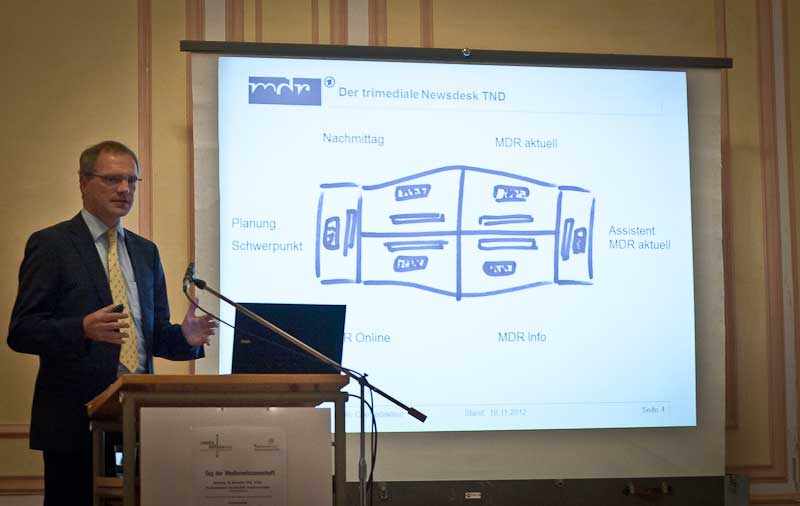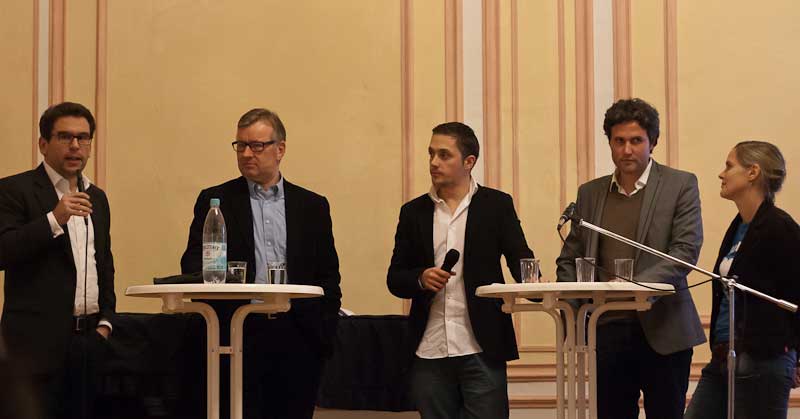Trimediality and Journalism In search of the digital future
On Media Studies Day, the Trier Media Studies Department celebrated its 15th birthday with exciting topics. Stefan Raue’s lecture on trimediality at MDR convinced with practical relevance, but remained pale when it came to the internet. The central question of the panel discussion: Can journalists help shape the digital future at all?
A study program celebrates its birthday
Last year, the question was what social media actually means for PR. This year, it was time for a celebration. The Trier media studies program celebrated its 15th anniversary. Our local newspaper, Volksfreund, wrote an interesting article about the evolution of the program – I do not want to provide a link because of the threatening “Leistungsschutzrecht”, so you have to google for “volksfreund 15 years of media studies”. Therefore, I would like to concentrate on the content aspects at this point, because there were two interesting contributions to be heard:
- Keynote speech by Stefan Raue (editor-in-chief of MDR): “Trimediality - fashion or perspective with a future?”
- Panel discussion: ”Current labor market requirements for media scholars”
Stefan Raue: Trimediality in Practice
“Media upheavals are supra-individual,” explained Stefan Raue, before launching into his lecture on his personal media history – with the leading medium of radio (until television established itself in the 1970s and 1980s) and his own record collection, which was supplemented by recordings from the radio. He then drew a line from television to the internet, which he referred to as a technical platform that had developed a momentum of its own.
In the further course of the lecture, Raue seemed to be very much anchored in classic media use. Despite all the prophecies of doom, television is still the leading medium. This is evident by looking at the figures, but not at all clear when you look at the individual media use of heavy internet users. Another theory: the internet means a loss of quality according to the classic standards of the media, but brings its own handwriting and aesthetics. Raue explained the first part of this argument in the course of his lecture: lower image and sound quality, abundance of offers – but he left the second part largely unclear. I will come back to this.
Trimediality using the example of MDR
Public media are facing a trimedial future: Since users use the internet, television and radio equally, “we do not want to disconnect from user reality,” but rather merge the three media into an integrated process.
This was the best part of Raue’s lecture: well-founded, practice-oriented, and detailed. Raue vividly explained the organizational structures of the MDR’s trimedial newsdesk – the leaders of various programs and departments sit together at one table to discuss how to present content optimally in all three media. In addition to the individual programs, the trimedial theme days are particularly noteworthy. These events treat a central topic in all media.

The daily consequences of this trimedial approach are also exciting. In addition to the obligatory cost savings – synergies, in other words – “our working atmosphere has changed”. There is “increased communication and collaboration”, especially between departments that otherwise have little to do with each other. After all, trimedial work is content-oriented: “We talk about topics, no longer about formats, whose boundaries are dissolving.” The disadvantage: the fear that one’s own format will loose its character and that one’s own program will loose its profile. Many trimedial projects have failed because of this fear. That is why the individual reporter does not have the task of covering all formats as a kind of jack of all trades – something like that fails in practice.
User reality and search engines
“We do not want to disconnect from the user experience” – this sentence has stayed with me as a conclusion of trimedial work. However, Stefan Raue did not go into much detail about the online part of this user experience. How does the feedback channel from the viewer to the trimedial newsdesk work? What criteria are used to decide which aspects of a topic are covered by which medium? How are the individual media intertwined, especially during the theme days? Is there any knowledge from user research about these days? Are there ideas for using the “second screen” – many users use a tablet or smartphone alongside television, so that additional offers for the program could run on them? While Raue’s lecture excelled well in the practical evaluation and implementation of trimedial aspects, it unfortunately remained pale in internet-oriented aspects.
What challenges will the media face in the future? Stefan Raue poses the main question: “How do we react to the abundance of media offerings?” The aim of the theme days is to “cut a swathe”.
However, Stefan Raue has little hope for orientation on the part of search engines. “I would like to give you something to think about: Are we returning to a random selection of topics as a result?” – a bold thesis, considering that search engines, recommendation algorithms and social filters are anything but random. An explanation would have been sorely needed here.
Panel discussion: What do media scientists need in the labor market?
The subsequent panel discussion focused on the demands of the job market for media scholars. Former and current students and lecturers were involved to answer questions:
- Svenja Siegert (journalist)
- Joachim Blum (editorial consultant)
- Sebastian Spang (Burda)
- Gernot Jäger (Zattoo)
Everyone on the stage agreed on one credo: flexibility and a varied education are the greatest assets for media scholars. “The trick is to have a lot of practical experience,” explained Gernot Jäger, adding: “In addition to internships, you should work as a freelance journalist – especially at the regional level. Because even if internships look good on your CV in the wider world, it is at the local level that you learn the trade.”
Senja Siegert explained that she had benefited from her layout experience – layout programs had just been introduced to journalism at the time, so knowing InDesign inside out helped.
Gernot Jäger advised against committing to a particular medium like radio too early: “Media scholars need to develop skills in communicating topics – only then should they think about the media.” For Sebastian Spang, this cross-media approach is often lacking in young professionals, especially in the area of social media. “Many applicants do not tweet – but it is so easy,” Svenja Siegert agreed.
Can journalists help shape the digital future?
An interesting insight that emerged during the discussion: although all the participants started out as journalists, only Svenja Siegert has remained in this field. “For me, journalism was a professional role, not a vocation” (Jäger), “interests change over the course of a lifetime” (Blum), “there are incentives from other areas such as PR – you have to be passionate about journalism” (Siegert) – personal reasons, one might think.

However, it actually became clear that there could perhaps be another problem with journalism: the impossibility of helping to shape the digital future. “For me, the question was: do I not want to be exposed to technological decisions or do I want to help shape them?” explained Gernot Jäger, while Sebastian Spang said that helping to shape them is fun. Joachim Blum also wanted to be involved in the changes in media use.
Since the discussion, I have often thought about it: Do journalists have no chance in shaping the digital future if they work as journalists? That would be a harsh judgment – after all, one would think that journalists, given their professional curiosity, their journalistic influence and their full-time engagement with topics, should be predestined for this.
It is not as if there are no journalists who are using the changes brought about by digitalization for their work. It is just that the people in Germany whom I would consider pioneers in this area work almost exclusively freelance – Ulrike Langer, Mario Sixtus, Richard Gutjahr… Are editorial offices still not able to integrate the new media situation into their work in 2012? It would be a sad verdict.
But perhaps there is hope. Svenja Siegert: “In the future, media will think in a user-oriented way – that is banal, but not a given.” Gernot Jäger thinks that companies will learn to follow their target groups. We will see.